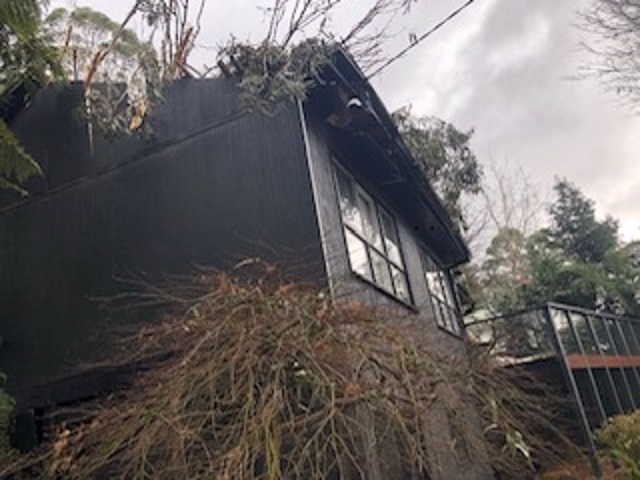As last year’s June storm came around, Monbulk local Leharna Black’s home was saved from damage but over a month later her life was unexpectedly turned upside down.
In July, a nearby Mountain Ash tree fell on her house, breaking through the top of the roof cavity narrowly missing the floor and Leharna underneath.
It’s believed the tree was unstable due to the storms the month prior and 7:30pm on Tuesday 27 July is a point in time Leharna Black said she will never forget.
Taken to hospital, the Monbulk resident suffered bruising and was released not long after admission.
“Not many people walk away from having a tree fall on them; so It’s quite extraordinary that I survived that,” Ms Black said.
While the roof caved in and Ms Black was injured by felled branches, she said the uphill side of Mount Dandenong’s eastern escarpment held the tree and prevented direct impact.
If the trauma of the event was not enough, Leharna was faced with the rebuild and finding accommodation.
“I’m studying psychology, and I had to drop one of my subjects. That’s all I had; one subject and house repairs. I didn’t have any social life, I didn’t have any energy left,” Leharna said.
“The house probably took up four to six hours a day for close to seven or eight months; like a full time job, and that’s why I got my house repaired. But if you work and you have children, you don’t have time to spend that sort of effort on dealing with all the agencies that you need to deal with to get your house repaired.”
Ms Black said her house was declared a total loss by her insurance company, meaning she was written a cheque for the total sum insured and was able to decide how she used the funds.
“I could repair my house, but it meant that I had to do the work – I had to find a builder, I had to deal with surveyors and draftsmen and engineers, I had to establish if the house was repairable, I had to get the house made safe…
“I felt like bait in a pool full of sharks and months.”
After successfully lobbying for a planning permit exemption to start the rebuild process, Leharna then obtained the building permit at the end of September with building commencing in the middle of October and finishing on 18 February.
“My house wasn’t completely demolished, but most of the internal walls had to be replaced, the roof had to be replaced, all the ceilings had to be replaced…the bathroom and the laundry had to be rebuilt,” Leharna said.
The builder involved did not have any other jobs at the time.
“That just shows you how much work is involved in repairing a house,” Leharna said.
Some members of the Dandenong Ranges community who were victims of the storms are still yet to see their house rebuilt after 12 months, and forced to face the question of what their next step will be.
While Ms Black, with a background in corporate work, has experience dealing with bureaucracy – she said others in the community were overwhelmed with the complex nature of finance companies and insurance companies alongside local and state governments.
“I know one woman that collapsed in the bank, [with] the stress of it,” Ms Black said.
“I even had my insurance company…tell me that with the Northern Rivers issues, that was going to delay everything even more because of course all of those people are in higher need than people down here – I thought that was appalling,” the Monbulk local said.
A spokesperson for the Insurance Council of Australia said as of May 2022, more than 34,000 claims have been made in the areas of Gippsland and the Yarra Ranges, with an estimated insurance loss value of $302.9 million.
“Repairs and rebuilds to property have been impacted in the area by the complex nature of the property damage, the accessibility of properties and the difficult terrain many properties are located and surrounded by,” the ICA spokesperson said.
“Adding to the complex local conditions, Australia has been and continues to be affected by labour, trades, and building supply shortages which continue to impact community recovery in both the insurance sector as well as infrastructure repairs and rebuilds.”
Last June, the State Government provided payments of $1,680 per week to households that were without power following the catastrophic storms, but Ms Black said priorities now need to shift.
“What people really need is their houses repaired, what they really need is help dealing with the systems and the processes that are overwhelming them,” Ms Black said.








